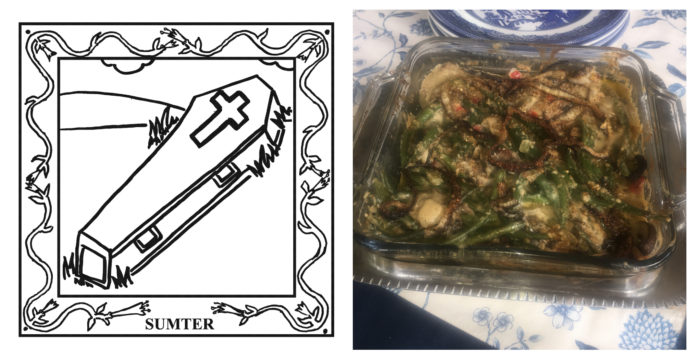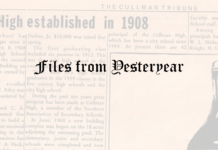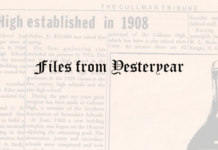
The Cullman Tribune is celebrating the Alabama Bicentennial (1819-2019) with statewide field reporting by Alabama Master Gardener/Botanical Artist Ben Johnson South. This year-long feature, “The 67-County Alabama Garden Party,” will spotlight different counties each week. Each county will get its own “quilt block,” along with a historical profile, and we’ll share a recipe specific to the area. At the end of the year, all 67 counties will be put in a book to commemorate the Bicentennial.
Sumter County
“Once there was a tree and she loved a little boy.” That is the oft quoted, opening line of “The Giving Tree” by Shel Silverstein. The story tells of the tree giving the boy shade and limbs to play on and then apples as the tree matures and ends with the boy aged into a tired, old man sitting on the stump of the tree.
The tree is happy to still be giving to the human she loves. It’s a wonderful tale, but if there were an epilogue, it could show the old man dead lying in a coffin made of the wood from the tree. PLANTS + PEOPLE together to eternity.
“A toast to your coffin. May it be made of 100-year-old oak. And, may we plant the tree together, tomorrow.” That’s a toast the early settlers would have known when Sumter County, Alabama was established in 1832.
Alabama has many taphophiles and a major destination for them is Sumter County. Sometimes called “Tombstone Tourists,” taphophiles are people who have a passionate interest in cemeteries, funerals, gravestones and all things related to human death and dying.
Sumter County in rural, southwest Alabama is a taphophile haunt because of The Coffin Shop built circa 1860-1870 in downtown Gainesville. This was the showroom for coffins built by Edward N. Kring. When Kring was alive you could select the tree from which you wanted coffin wood sawn and Kring and his woodworkers would custom build it.
Though born in New York State, Kring moved to Sumter County in 1860. When the American Civil War broke out, he volunteered with Company A, 5th Alabama Battalion, one of the first companies to leave the state. He served faithfully throughout the war in the Virginia Army. After Appomattox, he returned to Alabama and married in Gainesville where he lived the next four decades until his death.
Kring was a busy carpenter in Gainesville during the latter part of the 19th century. He built both the Methodist and the Episcopal churches, several homes and many downtown business structures. Kring had a large carpentry shop at the rear of The Coffin Shop and a large, timber-clad barn to store select, native woods from heavily forested Sumter County.
Coffin maker, Confederate veteran and community builder Kring died May 21, 1910. He was buried in a handsomely crafted wooden box built in his own shop in Sumter County.
The Coffin Shop in Sumter County was added to the National Register of Historic Places (NRHP) Oct. 29, 1985. The modest wood building is located in Gainesville on the east side of Highway 39 approximately 0.2 miles south of the river bridge. Taphophiles, here are your GPS Coordinates: 32.821542-88.158305.
Alabama, with its time-weaving respect of the past and appreciation of family history, is a major destination for taphophiles. Especially noteworthy are the “garden cemeteries” created here post-bellum in the 19th century. These were places designed to attract visitors and encouraged ancestor veneration. So that someone might linger longer, resting benches (often incorporated as part of a grave plot) and garden features such as elaborate fountains were added.
Famous naturalist John Muir said this of a Southern cemetery in his book, “A Thousand-Mile Walk to the Gulf”: “The rippling waters, the song of birds, the joyous confidence of flowers, the calm, undisturbed grandeur of the oaks, mark this place of graves as one of the Lord’s most-favored abodes of life and light.”
Here are only a few of the many beautiful and historic Alabama cemeteries that welcome you to enjoy the natural beauty, sculpted tombstones, final resting places of notable residents, vivid history and landscaped gardens:
*CHURCH STREET GRAVEYARD (Mobile)- Established in 1819, this peaceful-looking place is divided into three parts: Catholics, Protestants and “Others.” Many buried here among semi-tropical plantings were victims of Yellow Fever. The most popular grave to visit is that of Joe Cain who is credited with reviving Mardi Gras in Mobile; pilgrims leave shiny beads on his final resting place. One of my personal favorites entombed here is bon vivant writer, Eugene Walter, who was interred after approval of the mayor in 1998. Mobile is known for fanciful filigree wrought ironwork, and there are numerous examples here.
*ELMWOOD CEMETERTY (Birmingham)- Established in 1900, it has 412 acres and 130,000 internments. Many notables are buried here, including Denise McNair (a victim of the 1963 bombing of 16th Street Baptist Church), Coach Paul “Bear” Bryant (University of Alabama football legend), Mary Anderson (inventor of windshield wipers) and Eddie Kendrick (co-founder of the Motown group, The Temptations).
*COURTLAND CEMETERY (Lawrence County)- Established in 1819 this small cemetery has about 1,000 burials. Look for “the Pippen angels” which are four differently carved cherub statues atop the graves of the children of Samuel S. and Lida Foster Pippen; the four children were buried between 1896-1906.
*OLD OAKWOOD CEMETERY (Montgomery)- Established in 1812. Many Hank Williams’ fans make a country music pilgrimage here. There are 20,000 graves, including those of 700 Confederate soldiers and two Alabama governors. There is a marker honoring writer F. Scott Fitzgerald and his Montgomery native wife, Zelda Sayre Fitzgerald.
*CATHOLIC CEMETERY (Mobile)- Established in 1848, it includes sections for Catholic Brothers of the Sacred Heart, Daughters of Charity, Little Sisters of the Poor and Sisters of Mercy. Confederate Admiral Raphael Semmes and Father Abram Joseph Ryan “The Poet Priest of The Confederacy” are buried here.
*BLOCTON ITALIAN CEMETERY (West Blocton)- Established in 1896, this cemetery has many tombstones that are etched in Italian, and there are many coal miners buried here. West Blocton was built as a mining town.
*LIVE OAK CEMETARY (Selma)- Established in 1829. Eerily beautiful Spanish Moss sways from massive live oaks making gauzy drapings over the grave markers. The only candidate for vice president of the United States from Alabama, Rufus King, is buried here. Also, Mary Todd Lincoln’s sister, Elodie Todd Dawson, who was married to a Confederate colonel, lies here; her marker is a full-body, marble sculpture of her.
*MAPLE HILL CEMETERY (Huntsville)- Established in 1818-1822. Five Alabama governors are buried here and there is also a “potter’s field,” a common ground burial place for paupers and strangers.
*MAGNOLIA CEMETERY (Mobile)- Established in 1836, it has some of the most elaborate funerary art in the American South. Confederate General Braxton Bragg is buried here, as is Chappo Geronimo, son of the Apache Chief Geronimo.
*OAK HILL CEMETERY (Birmingham)- Established in 1869. The mostly popularly visited grave here is that of famous brothel madam, Lou Wooster, who also served as a nurse during the 1873 cholera epidemic.
Although Sumter County is historically celebrated for the burial boxes Edward Kring and his fellow carpenters created from pine and other native woods, there are many lively PLANTS + PEOPLE things to enjoy here, including these listed below.
*LIVINGSTON FARMERS MARKET- 115 Franklin Street, Livingston, AL 35470; Thursdays 8 a.m.- noon, June-September
*UNIVERSITY OF WEST ALABAMA- A beautifully-landscaped, 600-acre campus in downtown Livingston with a 54-acre lake and numerous gardens and nature trails, it was founded in 1835 as Livingston Female Academy only three years after Sumter County was established by the Alabama Legislature.
*ALMUCHEE-BELLAMY COVERED BRIDGE- Built of native timber in 1861, this is one of the South’s oldest and has been relocated for preservation to the beautifully-landscaped campus of the University of West Alabama (Livingston). Mr. Willie Lampley of the Sumter County office of the Alabama Cooperative Extension System suggested this as an ideal subject for landscape photographers and painters.
*FARM AND BUILDERS SUPPLY- A locally-owned supplier of seeds and gardening tools; 1310 North Washington Street, Livingston, AL 35470, 205-652-2528
*ALABAMA’S PLANT-RICH STATE SONG- Written by Sumter County native, Julia Tutwiler, an education leader and humanitarian, the song’s lyrics mention “orange trees, fertile prairies, snow-white cotton, perfumed south-wind whispers, magnolia groves, corn and wine, golden jasmine which woos the treasure-laden bee.”
*PLANTING AN IDEA- Earlier this year in a north Alabama cemetery, I attended a beautiful and touching graveside funeral for a much-loved gentleman who lived into his 90s. The man was very achieving, a pillar of the community and a person of means, but he planned for a simple send-off, including that his son, a gifted carpenter, would build his coffin. In all my years of attending funerals, this was the first time I remember one where the coffin wasn’t mass-manufactured. Alabama funeral laws still require a cement vault be placed over the wooden box, but this seemed to get us closer to an appreciation of the “circle of life” and returning to the earth. Perhaps Sumter County could help us reimagine our “garden cemeteries” and more sensitive and sustainable approaches to how we handle death, dying and the deceased.
Y’ALL COME to Sumter County on your 67-County Alabama Garden Party tour, and may the circle be unbroken.
Many thanks to Mr. Willie Lampley, coordinator of the Sumter County office of the Alabama Cooperative Extension System, which is your “go-to” place for all things PLANTS + PEOPLE in this part of the state. Also, thank you to Laurie Johnson for reinventing a classic comfort food with her healthier recipe for Sumter County “Freshened Up” Green Bean Casserole.
Sumter County “Freshened Up” Green Bean Casserole (One 8 x 8 casserole ~ 6 servings)
Southern comfort food = a casserole! Thank heavens for the angels that bring a comforting casserole. Whether to a happy holiday gathering or a meal for those remembering a lost loved one, traditional casseroles ring a familiar tune in our hearts. Recipes handed down from our grandmothers and mothers, by necessity, included canned, processed ingredients, usually accompanied by full-fat dairy products. While delicious, they sometimes get “looked down upon” in today’s health-conscious environment. Today, we have the advantage of year-round fresh vegetables and lower-fat ingredients that yield fresher, lighter versions of our well-loved favorites. This casserole starts with fresh green beans, mushrooms and onions and includes a homemade mushroom sauce and baked onion ring topping. It tastes fresher than the original (developed in the 1950s by a canned soup company), yet it is both familiar and satisfying. Here’s looking up to heavenly, Southern comfort food!
Ingredients:
- 1 lb. fresh green beans. Use small French beans if possible and slice in half.
- 1/2 lb. fresh sliced mushrooms- your choice of type
- 1 large sweet white onion, like Vidalia – 1/2 sliced into rings and 1/2 coarsely chopped
- 1/2 red bell pepper (optional)
- 2 tbsp. fine dried breadcrumbs
- 2 tbsp. grated Parmesan cheese
- Salt, black pepper and garlic powder
- Cooking spray and olive oil
- Low-sodium, low-fat chicken broth
- Half and half cream (optional – a minimal amount for extra creaminess)
Instructions:
- Preheat oven to 425F.
- Make onion topping – Spray the onion rings with cooking spray and toss with breadcrumbs, Parmesan cheese and black pepper. Place on non-stick cooking sheet and spray with cooking spray. Cook for about 10 minutes until brown, giving the pan a shake and rotating about halfway through. Remove and set aside. Reduce oven to 350F.
- Cook green beans – In a saucepan, cook sliced beans in boiling water for 8 – 10 minutes, until softened but they don’t lose their color. Drain and dunk into iced cold water. After cooled, drain again and press out excess water with paper towel.
- Make the sauce – In a deep skillet, heat a swirl of olive oil and 3 tbsp. chicken broth and sauté the onions, mushrooms and the peppers (give the onions a head start) until softened. Remove the vegetables and deglaze the hot skillet with ~ 1 cup broth. Sift ~ 3 tbsp. flour into the pan. Stir constantly to make a roux. Add more broth or flour until the roux is light tan and a medium consistency. Add few tbsp. half and half cream and cook into a thick sauce. Taste and season to taste with pepper, salt and garlic powder.
- Assemble and bake the casserole – Add the sautéed vegetables and the green beans to the sauce. Stir to incorporate and spoon into a (cooking-sprayed) 8 x 8 casserole dish. Bake at 350F for 20 minutes. Remove and top with the prepared onion rings and bake for another 10 – 15 minutes until very hot and bubbly.
- Enjoy your freshened up, but familiar comfort casserole.
Also, check out Alabama Bicentennial: 200 ways to save Alabama for the next 200 years.
Copyright 2019 Humble Roots, LLC. All Rights Reserved.























